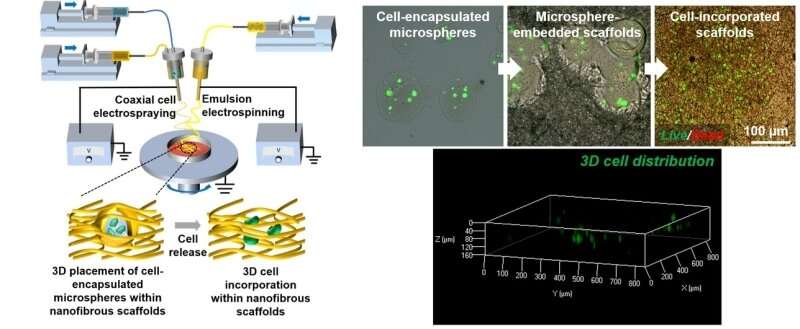Researchers develop new method for biomanufacturing of vascularized tissue

Vascularized structures infiltrated within a nanofibrous extracellular matrix (ECM) play vital roles in maintaining functions and metabolism of tissue and organs. Nanofibrous scaffolds are promising in tissue engineering owing to their ECM-mimicking architectures.
The vascularization of nanofibrous scaffolds remains challenging because of the difficulty in three-dimensional (3-D) infiltration and incorporation of vascular endothelial cells within nanofibrous scaffolds.
Dr. Zhao Qilong's group from the Shenzhen Institute of Advanced Technology (SIAT) of the Chinese Academy of Sciences, in collaboration with Prof. Wang Min's group from the University of Hong Kong, proposed a new method for biomanufacturing of vascularized tissue. The study was published in Acta Biomaterialia on Jan 27.
The proposed method could directly place living endothelial cells within bioactive nanofibrous scaffolds in 3-D through concurrent emulsion electrospinning and coaxial cell electrospraying.
Endothelial cells were encapsulated in hydrogel microspheres and deposited along with vascular endothelial growth factor (VEGF)-containing nanofibers in the scaffold fabrication process, resulting in nanofibrous scaffolds with 3-D embedded cell-encapsulated microspheres.
"After selective disruption of the hydrogel microspheres, the encapsulated endothelial cells are released, yielding bioactive nanofibrous scaffolds with tissue-like 3-D cell-incorporated nanofibrous structures," said Dr. Zhao.
As for the level of reactive oxygen species (ROS) of the cells in the hydrogel microspheres after the cell electrospraying and in the scaffolds after the cell release treatment, there were no significantly changes in compared to the cells normally cultured on the scaffolds.
Furthermore, the researchers found that endothelial cells could freely stretch, display enhanced intercellular connections, and maintain the phenotype in the bioactive nanofibrous scaffolds, indicating improved vascularization potential.
This study opens a new avenue for biomanufacturing of tissue-mimicking constructs with vascularized structures.
More information: Qilong Zhao et al. Three-dimensional Endothelial Cell Incorporation within Bioactive Nanofibrous Scaffolds through Concurrent Emulsion Electrospinning and Coaxial Cell Electrospraying, Acta Biomaterialia (2021). DOI: 10.1016/j.actbio.2021.01.035
Journal information: Acta Biomaterialia
Provided by Chinese Academy of Sciences



















